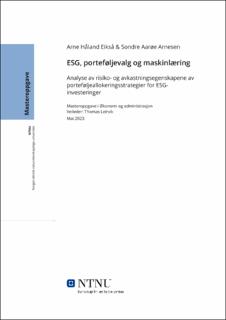| dc.description.abstract | Studien benytter tradisjonelle poteføljeallokeringsmetoder, samt maskinlæring for å analysere risiko og avkastningsforhold i ESG-vennlige aktiva i forhold til markedet og mindre bærekraftige investeringsvalg.
Datagrunnlaget til studien er fra perioden 2012-2022. Perioden er delt i en treningsperiode og en testperiode. Testperioden er januar 2016- til og med desember 2022. De tre første årene brukes til trening av porteføljene vi analyserer. Studien benytter månedlig data og logaritmisk avkastning. Data og kjøringer er hentet inn via STATA, og kjøringene er rensket og analysert i Excel-filen «Utregninger» som er vedlagt masteren. I tre av porteføljene ble det brukt kode i R for å konstruere. Dette ble gjort i STATA og do-filene er vedlagt oppgaven.
Vi anvender fem ulike porteføljestrategier; «Buy and Hold (B&H)», «Rebalansering (RB)», «Minimum Varians med og uten short (MVU) og (MVS)» og «Random Forest (RF)». I B&H, investeres 1/N av total investeringsverdi i hver ETF i porteføljen ved starten av testperioden, og holdes ut perioden. For strategien RB investeres 1/N av total investeringsverdi i hver ETF i porteføljen ved starttidspunktet for testperioden, og rebalanseres deretter hver måned tilbake til 1/N i hver ETF. MVU og MVS porteføljene er rebalansert årlig basert på optimale vekter estimert på foregående tre år. Til slutt lages en portefølje basert på maskinlæringsmetoden og Random Forest. RF konstrueres ved å bruke tekniske variabler som aktiva, indekser og makroøkonomiske faktorer for å predikere hvilke ETFer det skal investeres i.
Resultatene viser at porteføljene med ESG-vennlige aktiva generer en relativt, stabil periodeavkastning på omlag 60-70%. Denne avkastningen er på nivå med referanseindeksen for markedet som er anvendt i oppgaven. Resultatene indikerer at porteføljeallokering ved bruk av maskinlæring og Random Forest bidrar til å redusere volatilitet og avdekke markedstendenser som medfører bedre lønnsomhet. Videre indikerer resultatene at bransje og andre karakteristika ved aktiva som det investeres i er bestemmende for ytelsen og prediksjonsevnen til metoden. Potensialet ved bruk av maskinlæring fremkommer spesielt i analysene av porteføljene for de mindre bærekraftige investeringene. Her ender alle porteføljene med en periodeavkastning på rundt 50% med unntak av Random Forest som gir en totalavkastning på 167%. Random Forest som porteføljestrategi evner å avdekke markedstrender og markedskriser som vist ved covid-19 pandemien samt bedre risiko-og avkastningsforhold. Dette er noe som spesielt underbygges av den mindre bærekraftige porteføljens resultater. Studiens resultater indikerer totalt sett at investeringer i ESG-aktiva bidrar til langsiktig avkastning og redusert volatilitet sammenlignet med investering i selskap og bransjer som i mindre grad vektlegger og prioriterer bærekraft. Herunder at en passiv strategi vil være den mest foretrukne. | |
| dc.description.abstract | The study employs traditional portfolio allocation methods as well as machine learning techniques to analyze the risk and return characteristics of ESG-friendly assets compared to the market and less sustainable alternatives.
The data used in the study covers the period from 2012 to 2022, with an analysis period from 2016 to 2022. The first three years are utilized as a training period for the portfolios. Monthly data and logarithmic returns are employed. Data collection and analyses are conducted using STATA, with data cleaning and calculations performed in the Excel file "EXCEL file" attached to the thesis. For constructing three of the portfolios, R code is used within STATA, and the corresponding do-files named attached to this thesis.
Buy and Hold (B&H), Rebalancing (RB), Minimum Variance with and without Short (MVU and (MVS), and Random Forest (RF) are the five portfolio methods we employ. In B&H, 1/N of the total investment value is initially placed in each ETF in the portfolio and is kept there for the duration of the test period. For the RB method, 1/N of the total investment value is initially put in each ETF in the portfolio, and then rebalanced monthly to remain 1/N of each ETF. Every year, the MVU and MVS portfolios are rebalanced using predictions from the prior three years and their optimal weights. Finally, using Random Forest and the machine learning method, a portfolio is constructed. This portfolio utilizes technical variables such as assets, indices, and macroeconomic factors to predict the ETFs in which to invest.
The results indicate that the sustainable portfolios in the study generate a comparable period return ranging from approximately 60% to 70% relative to the study's benchmark. The findings suggest that portfolio allocation using machine learning and Random Forest techniques is profitable in reducing volatility and capturing market trends. Furthermore, the results indicate that the characteristics of the assets being invested in as crucial for the methods performance and predictive ability. The potential of machine learning is further emphasized by analyzing less sustainable alternatives. In this case, all the portfolios yield a period return of around 50%, except for the Random Forest portfolio, which achieves a total return of 167%. The Random Forest strategy demonstrates the ability to identify market trends, as evidenced by substantial avoidance of losses during the COVID-19 pandemic, but to a lesser extent for ESG assets. The study's results indicate that portfolio allocation with ESG assets is beneficial for long-term returns and reduced volatility compared to less sustainable alternatives, with the best strategy being a passive approach such as Buy and Hold. | |
